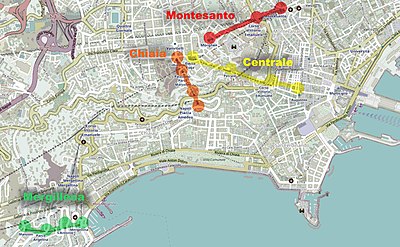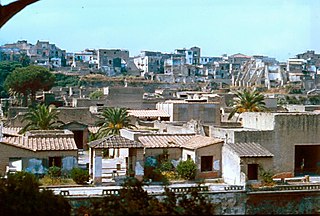
Ercolano is a town and comune in the Metropolitan City of Naples, Campania of Southern Italy. It lies at the western foot of Mount Vesuvius, on the Bay of Naples, just southeast of the city of Naples. The medieval town of Resina was built on the volcanic material left by the eruption of Vesuvius that destroyed the ancient city of Herculaneum, from which the present name is derived. Ercolano is a resort and the starting point for excursions to the excavations of Herculaneum and for the ascent of Vesuvius by bus. The town also manufactures leather goods, buttons, glass, and Lacryma Christi wine.

Piazza Venezia is a central hub of Rome, Italy, in which several thoroughfares intersect, including the Via dei Fori Imperiali and the Via del Corso. It takes its name from the Palazzo Venezia, built by the Venetian Cardinal, Pietro Barbo alongside the church of Saint Mark, the patron saint of Venice. The Palazzo Venezia served as the embassy of the Republic of Venice in Rome.
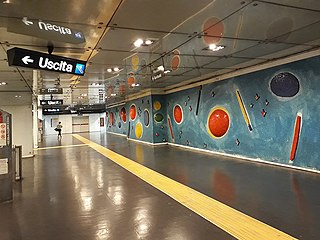
The Naples Metro is a rapid transit system serving the city of Naples, Campania, Italy and some parts of the adjacent comuni of its metropolitan area through Line 11. The system comprises four underground rapid transit lines.

Vomero is a bustling hilltop district of metropolitan Naples, Italy — comprising approximately two square kilometres (0.77 sq mi) and a population of 48,000.

The Centro direzionale is a business district in Naples, Italy close to the Napoli Centrale railway station. Designed by the Japanese architect Kenzō Tange, the entire complex was completed in 1995. It is the first cluster of skyscrapers to have been built in Italy or southern Europe.

Piazza Dante is a large public square in Naples, Italy, named after the poet Dante Alighieri. The square is dominated by a 19th-century statue of the poet Dante, sculpted by Tito Angelini.
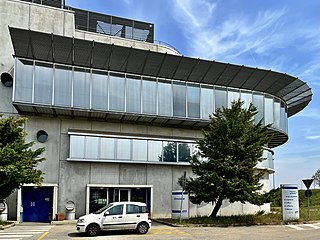
The Gruppo Torinese Trasporti (GTT) is a public benefit corporation responsible for public transportation in the provinces of Alessandria, Cuneo, Asti and the Metropolitan City of Turin. It was created in 2003 from the merge of ATM and SATTI, the latter responsible for railway connection in the province of Turin as well as for the Turin metro. GTT is now wholly owned by the Turin City Hall.

Line 1 is an 18.8-kilometre (11.7 mi) rapid transit line, part of the Naples Metro in Naples, Italy. As of July 2023, Line 1 connects 19 stations. It is operated by Azienda Napoletana Mobilità SpA (ANM). The line has been renamed Metrò dell'Arte reflecting the presence of contemporary art works installed in some of its stations.

The Chiaia Funicular is one of four funiculars in the public transportion system of Naples, Italy. Each system is a true funicular: an inclined railway with two passenger cars connected via cables, operating in concert.

The Mergellina Funicular, is one of four operating funiculars in the public transportion system of Naples, Italy. The system is a true funicular: an inclined railway with two passenger cars, connected via cables, operating in concert.
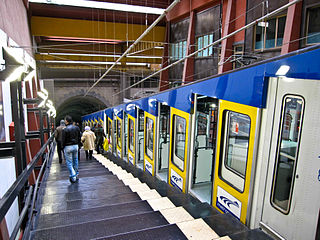
The Montesanto Funicular, is one of four operating funiculars in the public transportion system of Naples, Italy. The system is a true funicular: an inclined railway with two passenger cars connected via cables, operating in concert.

Duomo is an interchange station serving Lines 1 and 3 of the Milan Metro.

Mergellina is a station of the Naples Metro in Naples, Campania, Italy. The platforms serving Line 2 have been active since 25 September 1925, while the one serving Line 6 has been active since 4 February 2007.

The Naples tramway network is located within the city and comune of Naples, in the region of Campania, southern Italy. In operation since 1875, the network has waxed and waned in size and vitality over the years, and is now growing once again. It is now 11.8 km (7.3 mi) long, and comprises three routes, known as lines 1, 2 and 4.
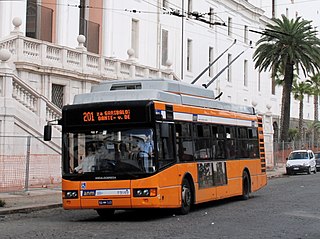
Trolleybuses in Naples provide a portion of the public transport service in the city and comune of Naples, in the region of Campania, southern Italy. From 1964 to 2015, two independent trolleybus systems were in operation, both publicly owned, but only that of Azienda Napoletana Mobilità (ANM) remains in operation. The ANM system opened in 1940, whereas the smaller trolleybus network of Compagnia Trasporti Pubblici di Napoli (CTP) opened in 1964.
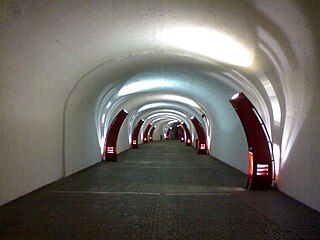
Napoli Piazza Amedeo is an underground rail station on the Villa Literno line in Naples, Italy.
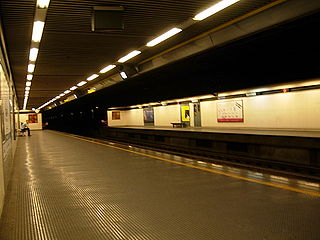
Vanvitelli is an underground metro station that serves Line 1 on the Naples Metro. It was opened on 28 May 1993 as the southern terminus of the inaugural section of Naples Metro, between Vanvitelli and Colli Aminei. On 5 April 2001, the line was extended to Museo, and Vanvitelli ceased to be the terminus.

The Petraio is a lineal urban neighborhood and pedestrian road in Naples, Italy. It descends from what was once an expansive upper agricultural area and connects adjacent neighborhoods to downtown Naples — terminating just outside the original perimeter walls of Naples, near the present day Chiaia district.

Medaglie d'Oro is a station on line 1 of the Naples Metro. It was opened on 28 May 1993 as part of the inaugural section of Naples Metro, between Vanvitelli and Colli Aminei. The station is located between Vanvitelli and Montedonzelli.

Piazza Ferdinando Fuga, popularly known as piazzetta Fuga for its modest size and called during the fascist period piazza Franco Belfiore to commemorate a young fascist who fell fighting in a clash in 1921, is a square in Naples located in the Vomero district. It is dedicated to Ferdinando Fuga, the architect who made many of his main works in Naples, including the Girolamini church and the Real Albergo dei Poveri.

